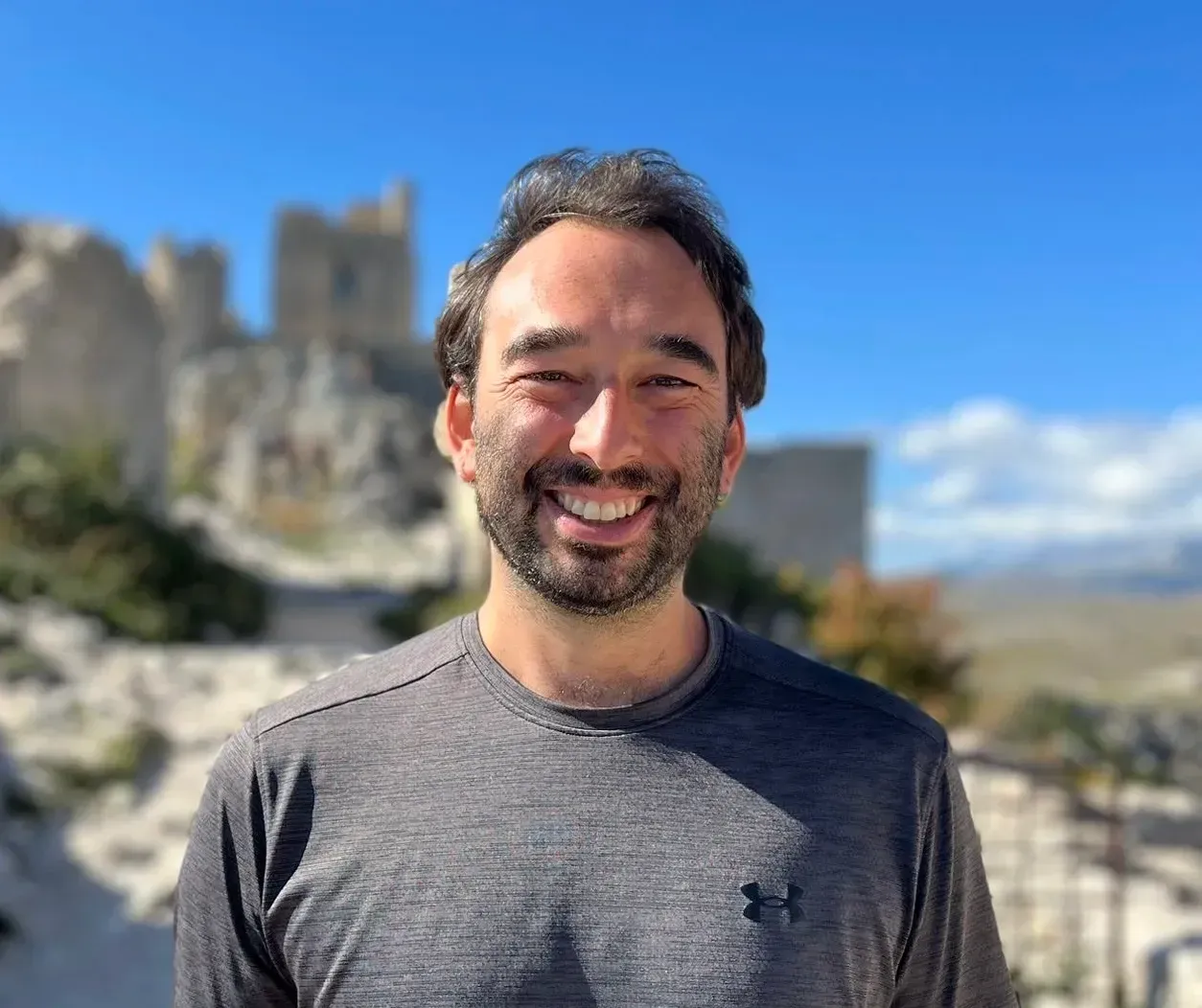
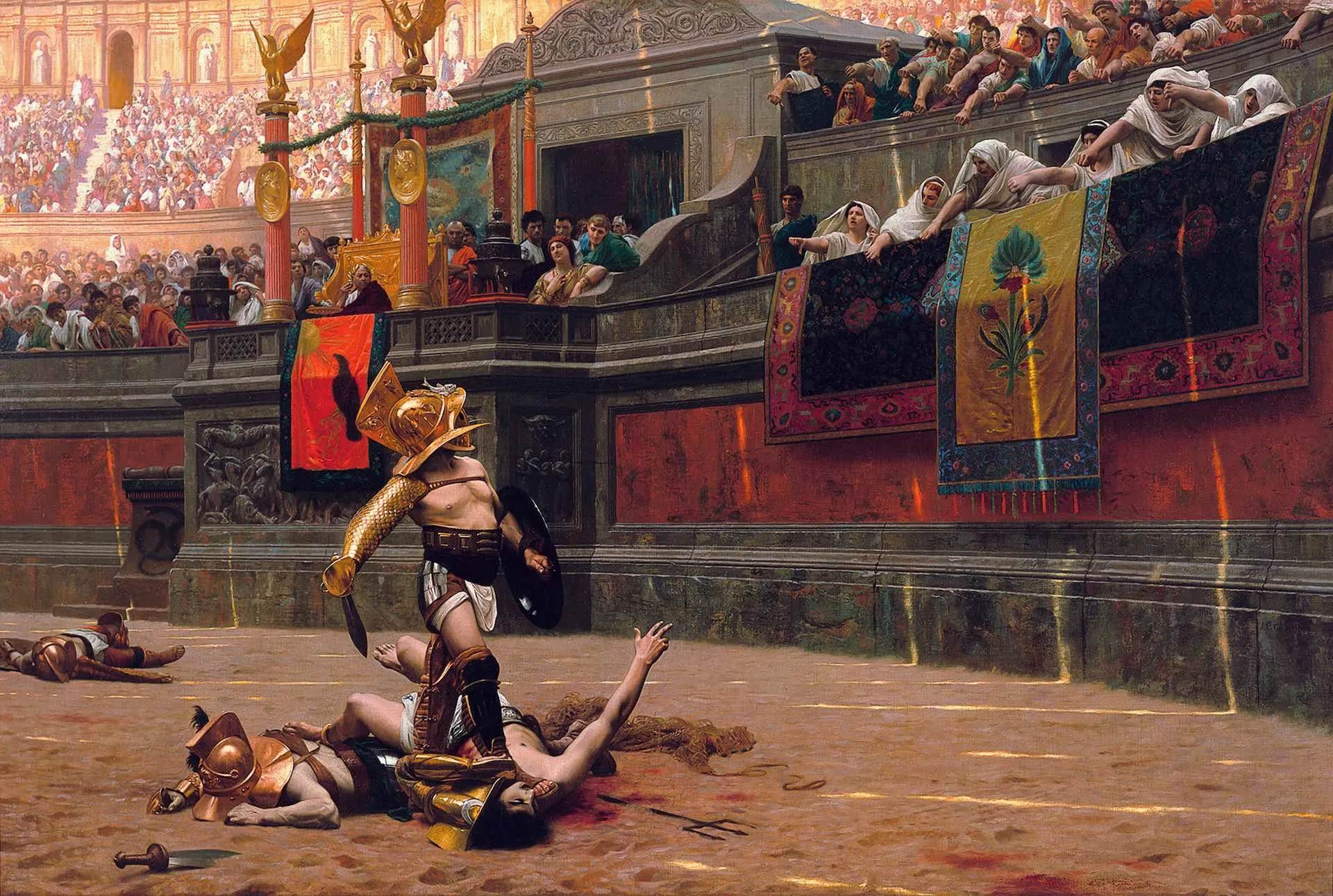

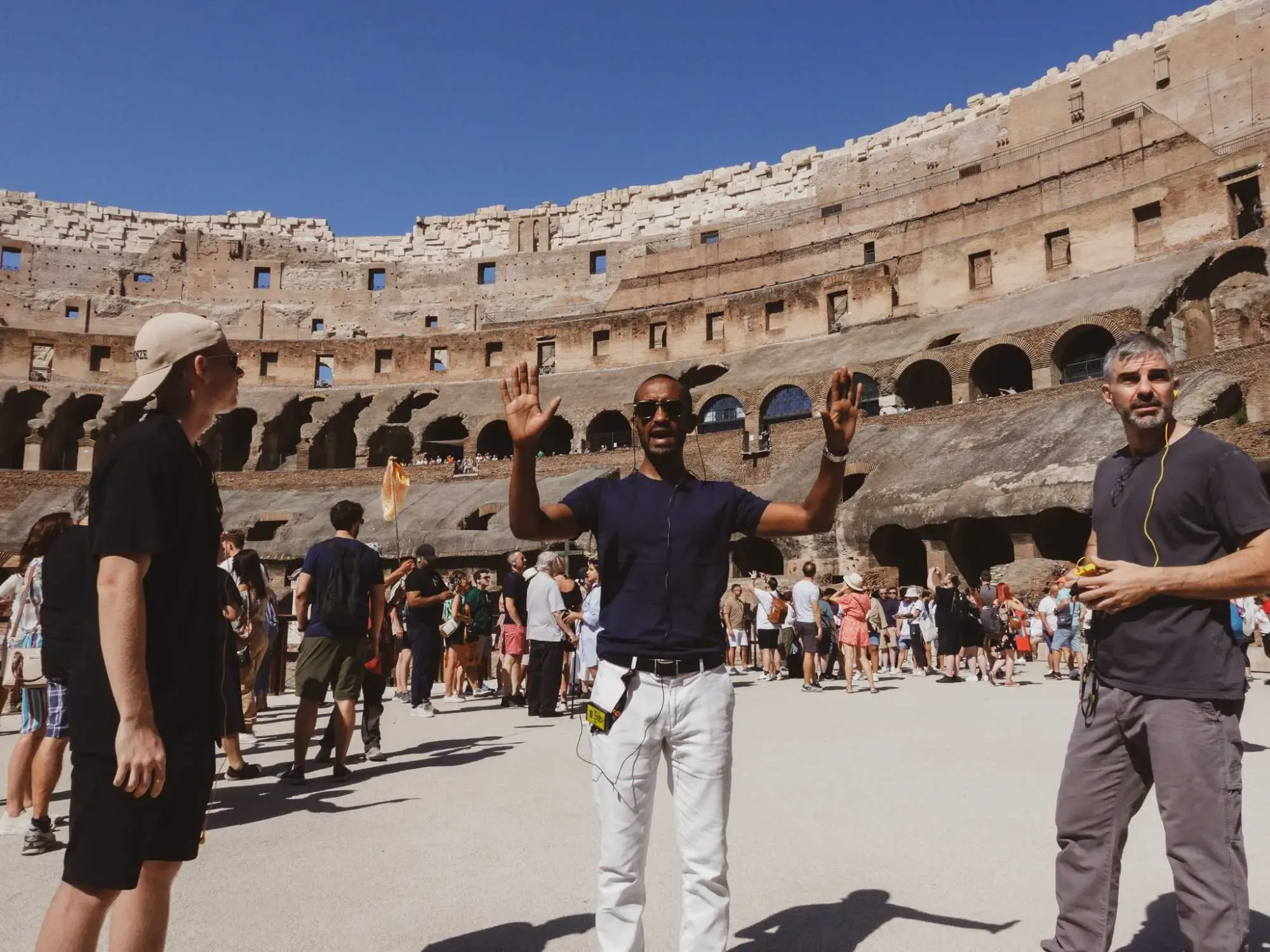
Ridley Scott's sword-and-sandals epic Gladiator (2000) injected new interest in ancient Rome and its gladiatorial celebrities. Starring a buff Russell Crowe as the wronged general-turned-gladiator Maximus Decimus Meridius (husband to a murdered wife, father to a murdered son etc.), the film did an excellent job portraying the life of a gladiator in ancient Rome.
And from the film flowed intense interest in the Romans and their gladiatorial games.
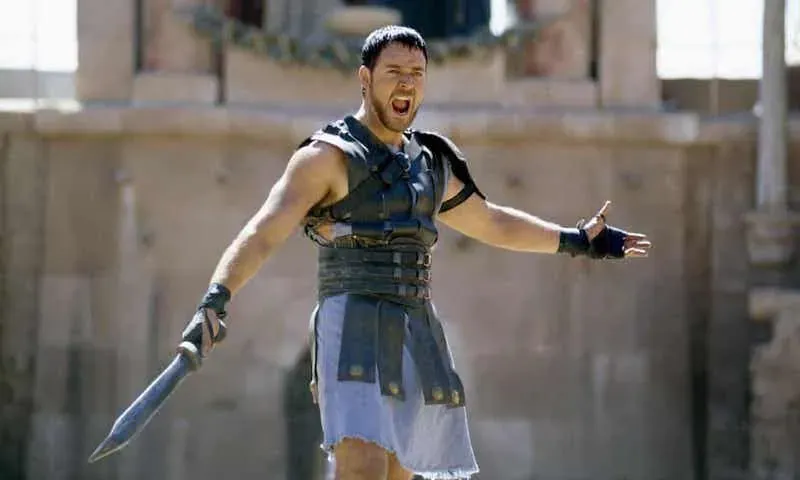
Russel Crowe in Gladiator (2000)
It is difficult for us to comprehend entertainment in ancient Rome. We see the games as barbaric blood sports, but they were much more than that. We also think it was the blood that drew the crowds, yet the ancient audience came to see skill and sportsmanship as well as the theatre of it all; just like fans of WWF today. Modern ideas and conceptions obscure our understanding of the games and the gladiators. Yes, people died in their thousands but is that really what it was all about?
Who were the gladiators? Why did they fight? And was it always to the death?
Armed combat outside of war was training for warriors and also seen at funerals. The Iliad and the Odyssey are filled with adventurous exploits, the deaths of nobles and their funerals. At these funerals, there were chariot races, athletic competitions and re-enactments of the lives of the dead heroes. The Roman funerals of the wealthy and important were a grand affair. The public would gather to watch the funerals of the great and mighty with displays of hand-to-hand combat that recalled the deeds of the deceased.
In ancient Rome, re-enactments of great battles were called munera and it seems this is where gladiatorial fights began. By the 3rd century BC, the gladiatorial fights were popular as entertainment. At the same time, Rome was expanding and fighting wars against foreign peoples like the Carthaginians of North Africa. Before long, conquered peoples (slaves and prisoners of war) were flooding into Roman territory and providing the manpower for these spectacles.
During the Imperial period, hosting gladiator fights in Rome became an extremely effective way for the emperor to show his generosity to the people. Being generous and seen in public were two of the most important factors of being a good emperor. In 70 AD, the emperor Vespasian addressed both these concerns by announcing to the citizens of Rome that he was building the greatest amphitheatre in the Roman Empire right in the heart of Rome.
Within 10 years, Vespasian had completed the Colosseum, and in 80 AD his son Titus celebrated the completion of the Colosseum with 100 days of games. The Colosseum became the capital of gladiatorial combat and trade in the empire. The citizens of Rome went crazy for it. The Colosseum facilitated the violent bloodsport for over 300 years and the last clear record of fighting between gladiators in ancient Rome is in the mid-430s.
The gladiators were foreigners, mostly slaves and prisoners of war. We imagine they were forced into it, but that is not entirely the case. Gladiators, particularly those like Maximus, had contracts. They were bound to their trainer/manager the lanista for a minimum of five years during which they trained like our modern sportsmen. After that, if they were still alive, they were granted their freedom. As slaves they could also buy their freedom earlier if they had earned enough money.
As gladiatorial fights became more popular, they gained recognition and fame among the audience. Think of Cristiano Ronaldo and Tom Brady; men wanted to be like them and ladies wanted to be with them. Also, if they won their fights there were huge cash prizes, most of which went to the manager of course. This meant later on, under the empire even the Romans themselves were attracted by the possibility of fame and fortune; some sold themselves into slavery hoping for glory.
Spartacus is undoubtedly the most well-known gladiator, even before the sexy sword-and-sandal American series. His story is a little like Maximus’. He was a soldier from Thrace (modern-day Bulgaria, Greece, and Turkey), who was captured by the Romans and became a gladiator. He trained in a famous gladiator school in Capua, near Naples, which rivalled Rome for gladiators during the late Republic.
In 73 BC, Spartacus escaped the gladiator school with 70 other slaves. An excellent leader and tactician, he caused serious problems for the Roman legions who chased him all over Italy under the leadership of Crassus. Spartacus had over 70,000 followers - slaves, farmers, shepherds, and even disenchanted Roman veterans. Later historians would refer to this uprising of the downtrodden as the Servile Wars.
This was the first serious uprising Rome faced from within, and ended in a grisly display of power when 6,000 men were crucified along the Appian Way.
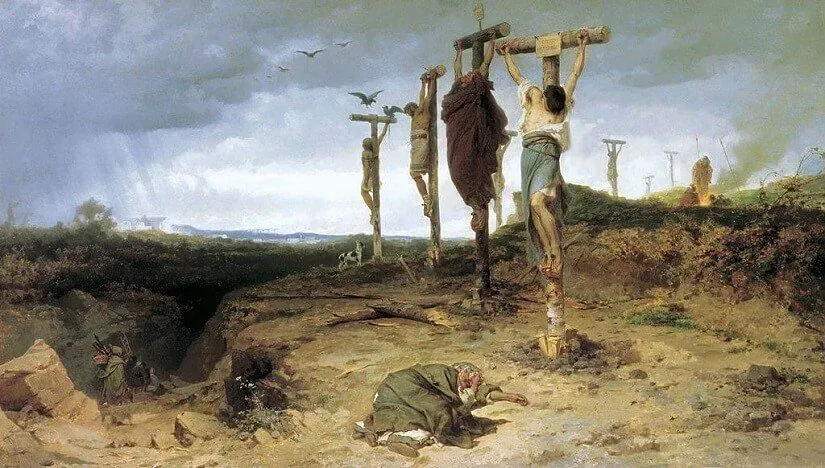
Spartacus’ followers crucified along the Appian Way
The word gladiator literally means swordsman and comes from the word gladius, (sword). The gladius was the standard weapon of the Roman army - a lightweight double-edged sword. Roman units fought in tight formations which favored the quick attack of a short sword.
The gladius' success on the battlefield led to it becoming a weapon of choice for the gladiators in ancient Rome. But not all gladiators fought with a Gladius. Different types of gladiators carried different weapons and bore varying armour and costumes.
In the early days, gladiator types were inspired by Rome's conquered nations. You had the Samnites, a Latin tribe, the Gallus from Gaul (modern France), the Thraex from Thrace (modern Bulgaria, Greece & Turkey), and the Hispanicus from Spain – and they used weapons and armour from those nations.
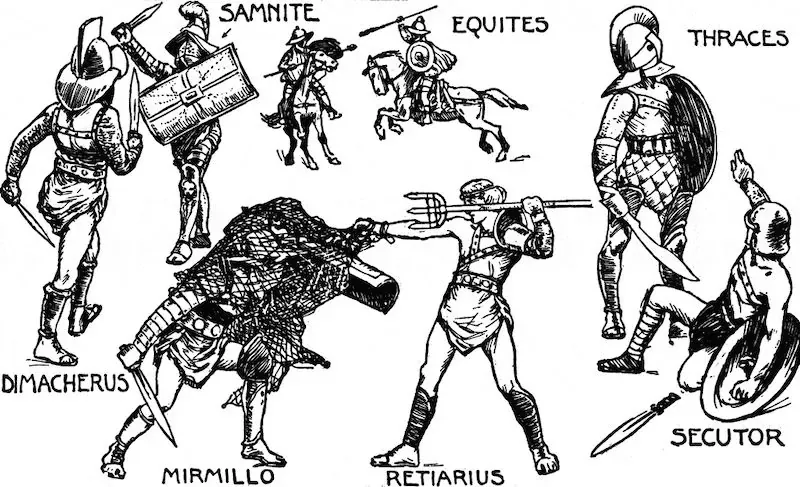
Types of Gladiator in Ancient Rome
We imagine millions of people died for the bloodthirsty crowd, but this is a myth. True, many people died, with criminals and prisoners of war used as fodder for animals. But gladiatorial fights were rare, perhaps only five or ten times a year. These fights were expensive, especially if you wanted the stars.
Gladiator schools trained men and hired them out for the games. Remember Oliver Reed in Gladiator? He takes his gladiator troupe around like a travelling circus. Fighters were rented out like entertainers and if they died - you had to pay double! if it was to the death, why have a ref? In fact, it was in everyone’s best interest not to kill the gladiators.
In the ancient sources, we hear about the extravagant games of the emperors and the thousands of men and animals that died. But this didn’t happen all the time, when these games are mentioned by the ancient writers, it is because they were so over the top!
Rome was a military society, we cannot imagine their mindset, let alone how violent ancient society really was. We also can’t imagine our lives without weekends or jobs that are short-term, temporary gigs with no benefits. The importance of festivals (bank holidays) and games to the man on the street are completely lost to us.
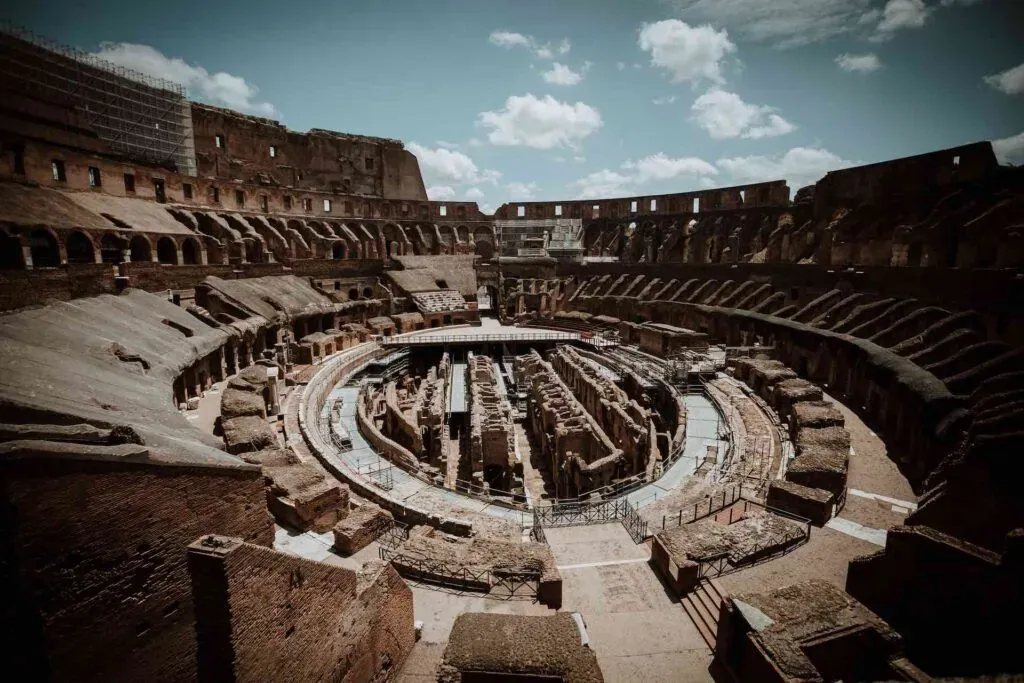
Colosseum arena floor
Imagine you are working as a labourer from dawn, you are barely making a living and never get a day off. Then the government declares twelve days of holiday and free entertainment for everyone! At the games you might get free food, the organisers might throw gifts into the crowd and you get to see your favourite sports heroes. Everyone had their favourites, and showmanship was a big part of it, as well as flashy costumes with coloured plumes and decorated armour.
No doubt the men came to see a skilled fight and the ladies came for the half-naked rippling bodies.
Enjoy reading about the Gladiators in ancient Rome? Come and discover the history first-hand on our Colosseum Palatine Hill and Roman Forum tour.
Want to visit the step out onto the arena floor? Check out our Colosseum Arena Floor tour!

No headings found in content.
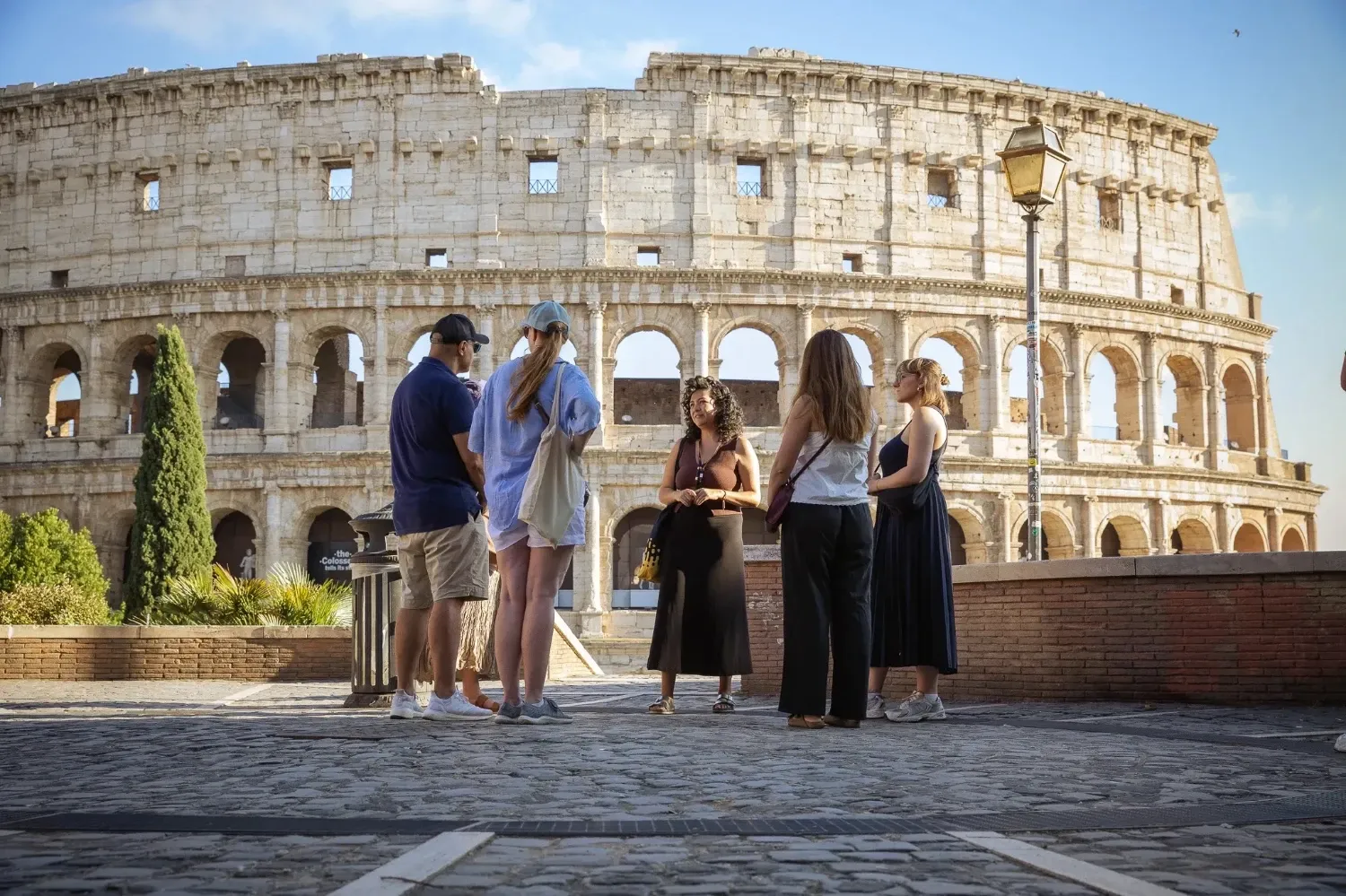
Short on time but big on curiosity? Our Colosseum Walking Tour is your express pass to ancient Rome, without waiting in queues. In just 1.5 hours we’ll walk the same route once trodden by gladiators and discover the drama, architecture, and daily life of the Roman Empire, all from outside its most legendary landmarks.
We’ll start just outside the Colosseum, where your guide will bring its epic past to life, from bloody battles to groundbreaking Roman engineering. Then, we’ll stroll through the Forum of Augustus, where politics met propaganda, and on to Trajan’s Column, once the empire’s grandest shopping and storytelling space. You’ll hear not just about emperors but also about the shopkeepers, citizens, and stories that represented everyday life in the Ancient City.
For the grand final we’ll enjoy a breathtaking view of the Roman Forum, the true heart of ancient Rome, where religion, power, and public life collided. It’s here where you’ll begin to truly understand the bigger picture of Rome’s rise, rule, and reinvention.
This tour is perfect for travellers who want maximum insight in minimal time, so what are you waiting for?
Book now, and experience the stories, secrets, and sights that shaped the Eternal City, no tickets, no lines, just unforgettable history.
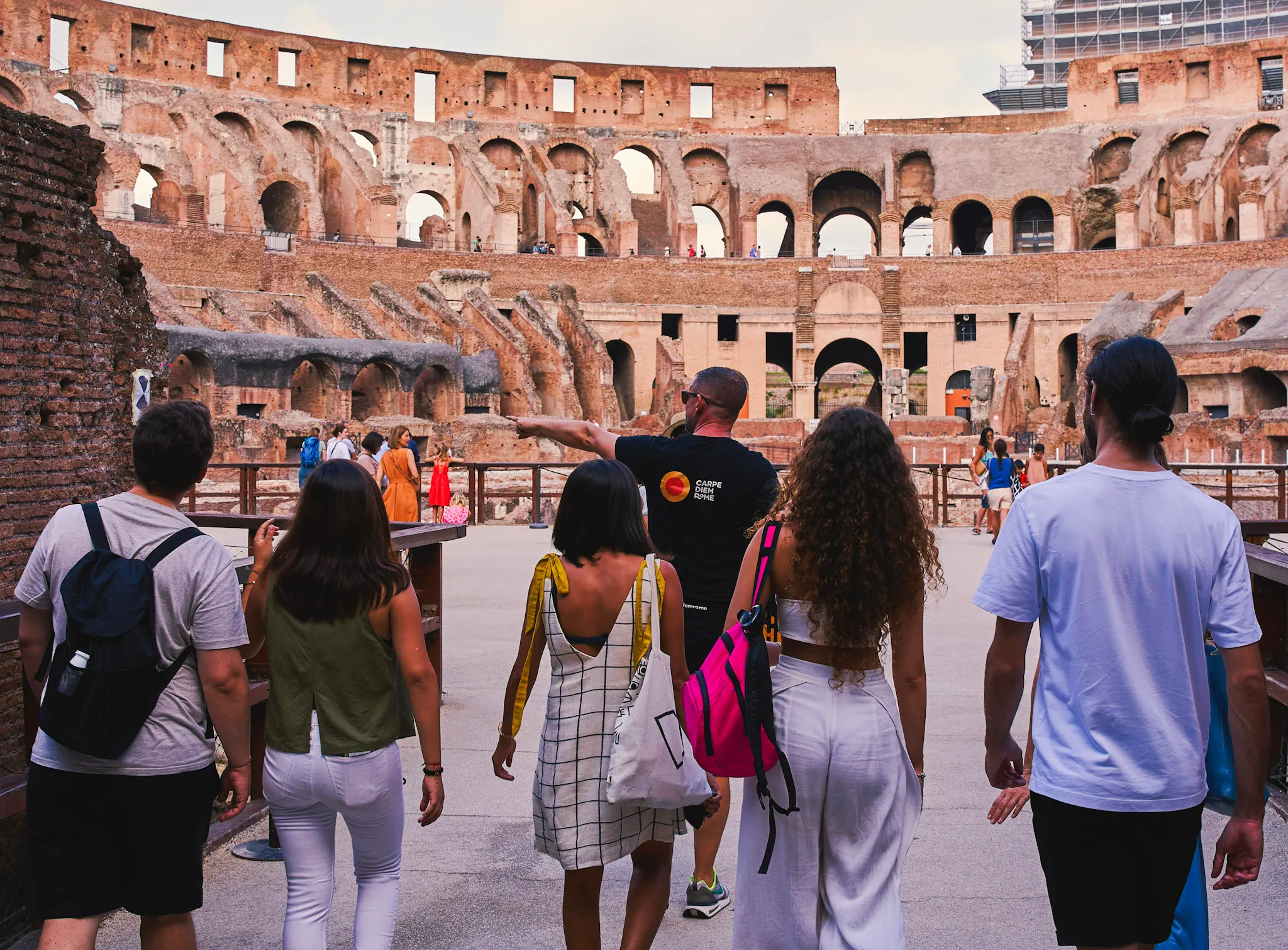
Ready to travel back in time to experience the might of the Roman Empire? Our small-group Colosseum guided tour lets you step straight into ancient Rome, no time machines (or long lines) required. With timed -entry and fast-track access and an expert licensed guide, you’ll breeze past the queues and straight into the jaw-dropping world of emperors, gladiators, and ancient stories that will stick with you forever.
We’ll start our 3-hour adventure at the Colosseum, Rome’s most famous amphitheatre and the site of some of the most bloody public spectacles in history. Your guide will reveal the story and secrets behind this impressive monument and provide answers to your burning questions:
The answers might surprise you, but not more than the exclusive above-the-arena views that offer a new perspective of the Eternal City.
After your immersive Colosseum tour, we’ll ascend Palatine Hill, Rome's legendary birthplace. It was here that Romulus founded his city, after murdering his brother Remus, and here where the rich and famous of the Roman Republic had their homes. During the time of the Roman Empire, the Palatine Hill was the site of the emperor's palace, royal intrigue, and some of the city's best panoramic views. This is where myths met marble, and emperors ruled with an iron fist.
Then we will head down into the Roman Forum, once the buzzing hub of Roman public life. We’ll wander through the ruins of ancient temples, triumphal arches, and the political stages that shaped the Roman Empire, all brought to life through the expert storytelling of your licensed guide.
With the comfort of a small group, a well-paced itinerary, and the best value for money of any Colosseum tour, this isn’t just a tour, it’s a once-in-a-lifetime experience through the rise (and fall) of ancient Rome. Spots fill fast, so grab yours and make your Roman holiday legendary.
Travelling with 6 or fewer people? We recommend upgrading to our semi-private tour of Ancient Rome for a more personalised experience. With this semi-private Colosseum tour, you can explore at a more relaxed pace, enjoy a more intimate experience with the people you care about most, and experience the personalised attention of a guide who can answer all of your burning questions.
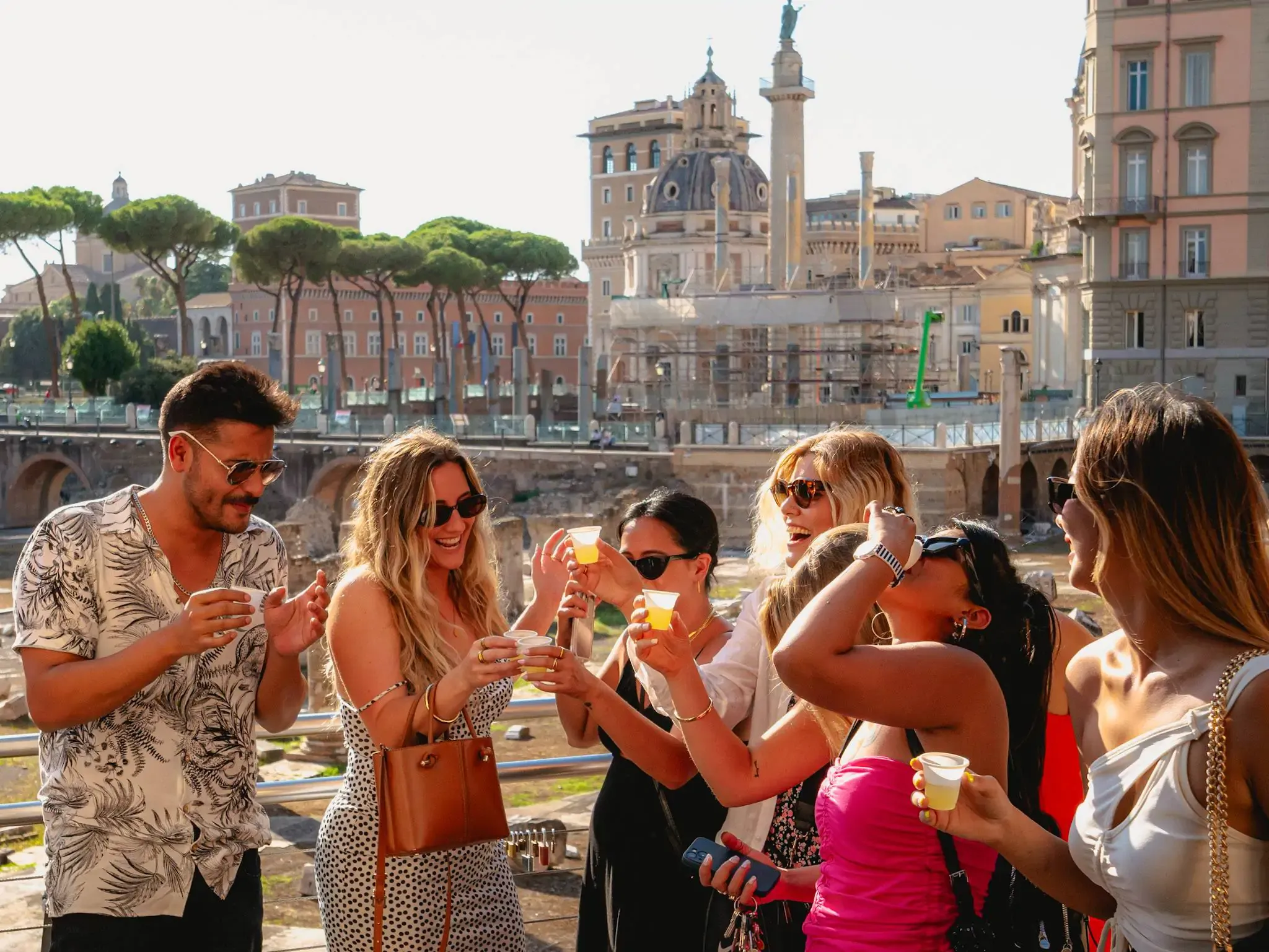
One of the best ways to meet people in a new city is to grab a drink together, and few city serve up more iconic drinks than Rome. Whether you’re travelling solo or with a group, for a long vacation or a short city break – our Rome Tipsy Tour is for you!
This unique nightlife experience combines all our favourite elements of travel: discovering new places, being immersed in different cultures, meeting fun people, and trying out a range of delicious drinks! It’s not a run-of-the-mill bar crawl. It’s a sociable tour that gives you a real taste of with Rome’s sights, stories, and signature drinks in a friendly, relaxed atmosphere with fun, local hosts. We also welcome sober travellers who want to join for a social experience but who want to forgo a hangover, so we’ll have non-alcoholic options available as well!
You’ll meet your guide and group at Piazza Madonna dei Monti, where we’ll break the ice with a warm Italian welcome – aka, a refreshing glass of local wine. After saying cheers—salute—we’ll head into Monti, an uber-trendy district filled with quirky bars and cobblestoned streets, and plenty to unpack. In ancient Rome, Monti was known as a suburra – the red-light district of Rome where prostitutes plied their trade and gangsters once roamed. As we wander through the cobblestone streets your guide will tell you scandalous stories of sex and bloodshed that you won’t hear on your typical walking tour.
After so much scandal, you’ll surely need a drink. So at our first stop on the Rome Tipsy Tour you’ll get an extra stiff one. The spotlight will be on Carpano Classico a venerable vermouth with a curious story! Unravel the history of the man who made it – Antonio Benedetto Carpano – back in 1786 whilst sharing some sips with your newfound friends.
We’ll keep the night going with some more saucy stories before trying a classic Italian Spritz. Indulge in the bitter flavours of Aperol or Campari Spritz while enjoying dolce far niente, the sweetness of doing nothing—apart from getting tipsy of course!
Our final stop is Rome’s most iconic road, the Via dei Fori Imperiali, leading down to the Colosseum. The views of the ancient city are best enjoyed after dark with an ice-cold Limoncello – trust us. Sip away as your guide tells shocking stories of the power-hungry Roman emperors who once ruled the known world.
At 11 p.m., the Tipsy Tour officially ends, but the night out begins! We will continue drinking with our new friends at some of Rome’s most popular bars!
Don’t miss out on this once-in-a-lifetime experience. We promise to make your night in Rome one you’ll never forget! Skip a boring walking tour, and come get tipsy with us.
Book your spot now!
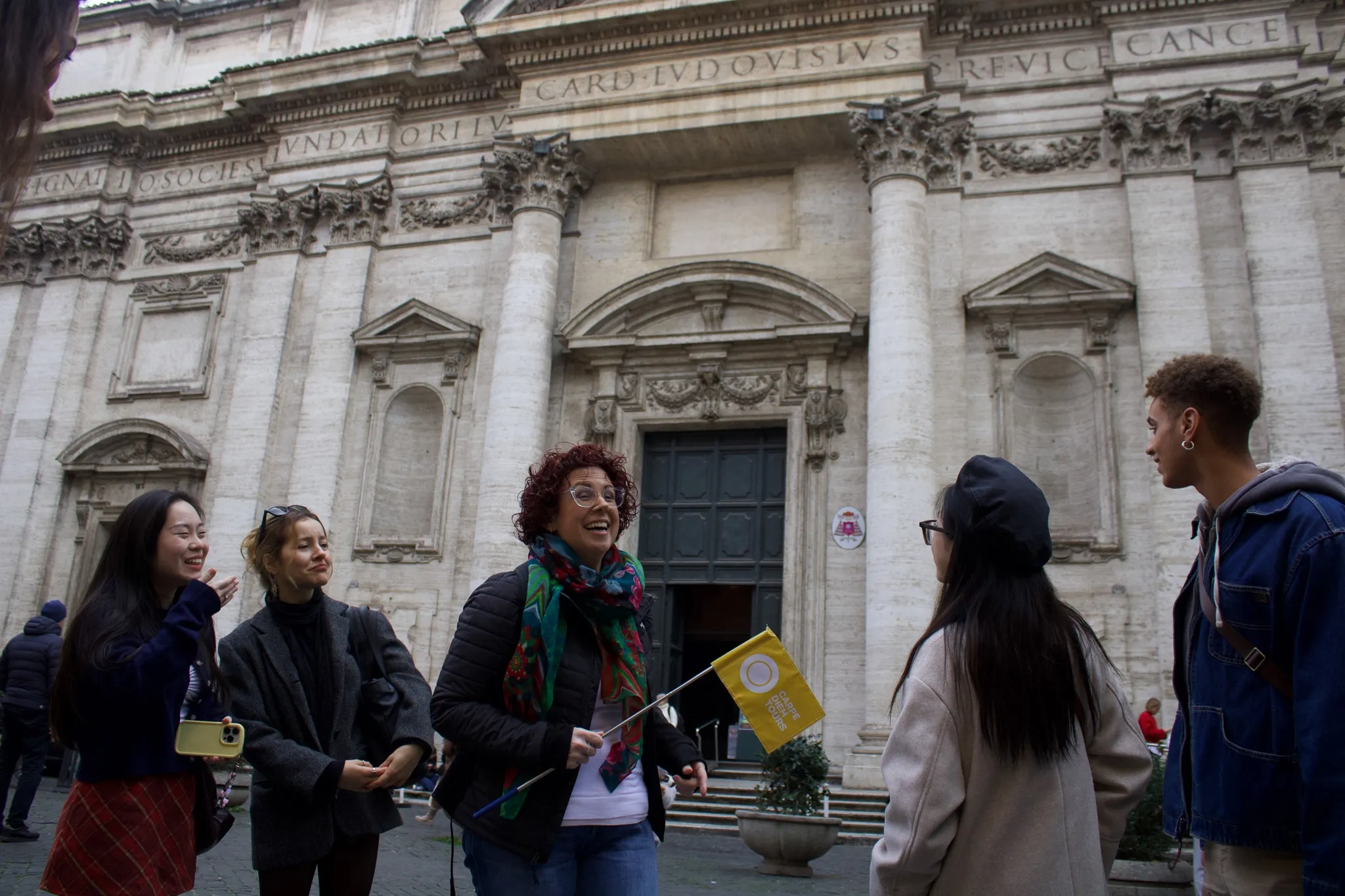
Explore the wonders of the Eternal City on our Wonders of Rome Walking Tour! As you get your bearings around Rome’s cobbled historic centre, your expert storyteller will bring Rome’s most must-see sites to life, including the Pantheon, Trevi Fountain, and Piazza Navona. Take photos, make memories, and most importantly, get the most out of your time in the Italian capital!
Your guide will share the city’s secrets and narrate its story in a way that will make you feel like you’ve stepped back in time – from explaining how the stunningly intricate churches and palaces were erected, to how the grand fountains were used to channel water throughout the city.
After meeting your guide at Piazza d'Aracoeli, we'll head to the Piazza Venezia, the crossroads between the ancient city and the modern capital and one of the most scenic squares in Italy! We'll then admire Trajan’s Column, a second-century AD monument which portrays the bloody victory of the emperor Trajan in his Dacian wars in Eastern Europe.
After taking a moment to marvel at the imposing Altar of the Fatherland, we’ll make our way to the iconic Trevi Fountain. Toss a coin into the fountain, spend a moment soaking in its sounds and scenery (metaphorically, not literally!), and uncover the fascinating stories behind the fountain’s statues and symbols.
We’ll then make our way to the Pantheon where the spectacle of the 2000-year-old dome will blow you away. Marvel at one of the best-preserved buildings of the ancient world, hear the story behind the man who built it, and discover the shocking architectural secret behind how the dome is (or isn’t) supported!
The square is situated near some of Rome’s best and most vibrant bars and restaurants and your guide will be happy to recommend where to go.
Our Rome Walking Tour is suitable for people of all ages and fitness levels. You can expect this memorable experience to last about two hours, which leaves you with more than enough time to explore the city beyond. Make sure you don’t miss out.
Secure your spot today!
.webp)
Join us on a journey through Roman history on our immersive Rome by Night Walking Tour. Your expert guide will share the city’s secrets, history, and fascinating tales—from antiquity through to the modern day, and at a pace to suit you.
Our tour starts in Rome’s most picturesque square, Piazza Navona, where the ancient Romans used to watch athletic contests (agones). Today’s piazza sits above the ancient stadium and boasts Gian Lorenzo Bernini‘s stunning Fountain of the Four Rivers as its centrepiece.
A five-minute walk from Piazza Navona takes us to the world-famous Pantheon. Constructed more than two-thousand years ago by the eccentric emperor Hadrian, the Pantheon was consecrated as a monument to all the pagan gods (pan theos, in Greek meaning all the gods). This second-century temple is one of the best-preserved monuments in the Roman Empire and its unreinforced concrete dome still perplexes architects.
Our next stop is the iconic Trevi Fountain. Immortalised by Anita Ekberg wading through its water in Federico Fellini’s iconic film La Dolce Vita, the Trevi Fountain one of the most romantic spots in the Eternal City. Snap your photos of the monument in the moonlight, listen to your guide decipher its symbols, and toss a coin over your shoulder to guarantee your return to Rome.
We emerge from Rome’s winding backstreets onto Piazza Venezia. Stretching from the foot of the Capitoline Hill, against the backdrop of the Altar of the Fatherland, Piazza Venezia is Rome’s most recognisable square, and a repository of history involving figures from Napoleon to Mussolini.
Your guide will lead you down the Via dei Fori Imperiali, the boulevard that cuts through ancient Rome, past Trajan’s Column and alongside the forums of Trajan, Augustus and Nerva. Your guide will feed your curiosity and nourish you with knowledge about ancient Rome and its empire as you make your way towards the most famous monument of all: the Colosseum.
The Colosseum is one of the most awe-inspiring attractions that has survived from antiquity. As a colossal feat of architecture and engineering, its form has been replicated throughout the ages, manifested in stadiums and sports venues around the world. But while its form is familiar to us, the spectacles it accommodated are entirely alien, and remind us of the violent nature of Roman culture.
Group sizes are 15 people maximum.
Book your spot now to avoid missing out!
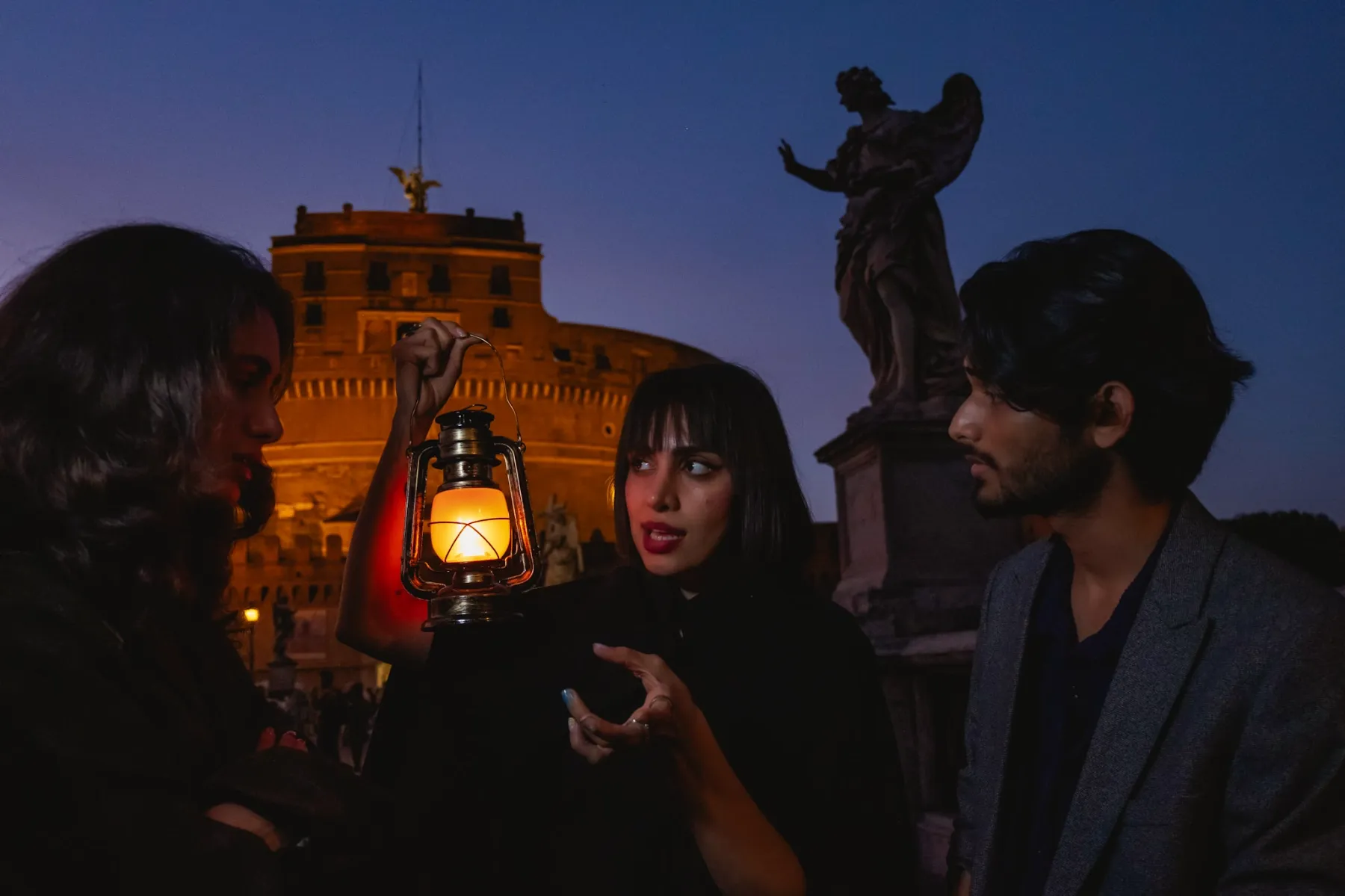
Rome may well be the world’s most beautiful city, but after dark a more sinister side emerges. The ghosts of popes, emperors, and artists lurk on every corner, their lives claimed by tragedy and conspiracy across more than 2,000 years of history. Our Rome Ghost Tour is not for the faint hearted — you’ll hear the ghastly tales of beheadings and murder that are sure to keep you up late at night.
Your Rome Ghost Tour starts at Campo de’ Fiori, a central square, where you’ll be treated to the tale of Giordano Bruno, one of Rome’s greatest minds who got on the wrong side of the church. After learning about his grisly end, you’ll begin to explore the city. Venture through medieval backstreets; visit an ancient church adorned with skulls; and step inside the home to a mysterious order of monks. Discover the childhood home of one of Rome’s most infamous executioners; see the site of one of Rome’s most infamous prisons; and pass by a poisonous perfumery where cosmetics killed.
Your tour ends at the imposing Castel Sant’Angelo, where your guide will reveal the horror of Rome’s most disturbing executions. If you’re (un)lucky, you might even encounter a ghost or two.
No matter what, you’ll never see Rome the same way again.
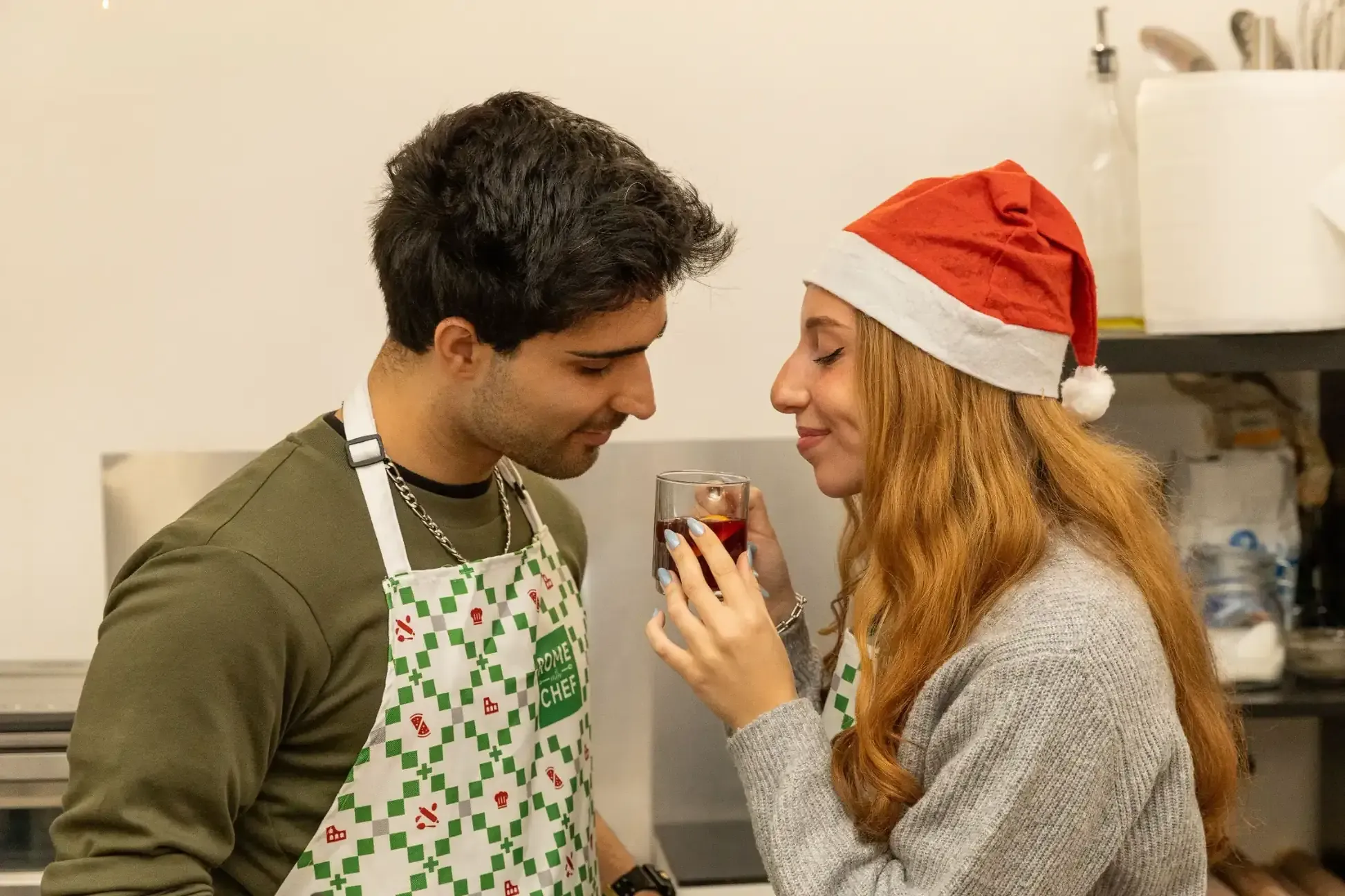
We’re spinning up festive flavours, Italian-style! From December 1st until January 6th, our pasta and tiramisu class gets a holiday twist, complete with mulled wine magic and made-from-scratch fun.
Learn to cook like an Italian in this small group pasta & tiramisù cooking class that gives you mastery over the country’s best-loved classics. Over the course of three fun-filled hours, you’ll enjoy the expert guidance of our fluent professional chef and get hands on recreating real Roman recipes, culminating in a well-deserved dinner and dessert.
Situated in our centrally situated air-conditioned cooking school, your interactive class will give you the true sense of an Italian nonna’s loving kitchen. Led by an enthusiastic and knowledgeable English-speaking chef, our cooking masterclass is perfect for kids and adults, beginners and experts.
Savoiardi (ladyfingers) are gently dipped in rich coffee before being layered with dollops of delicately mixed eggs and panna (cream). Finished off with a sprinkle of cocoa, these delicious desserts are set aside to rest in time for an after-dinner energy boost. In fact, the espresso within a tiramisù is what gives it a name that translates literally as “pick me up”!
Rolling up our sleeves, here is where we channel our inner nonna. Mixing, kneading, rolling, and shaping our fresh pasta from scratch will work up a sweat but result in elegant end products. We will then combine these carefully crafted creations with the flavours of the season and locality; be it twangy cacio e pepe or creamy carbonara.
How else to conclude your cooking class than by fully indulging in your culinary creations! Celebrate your accomplishment with family-friendly company, a gorgeous setting, and a glass of local wine or prosecco.
Whether returning a culinary maestro or a self-proclaimed novice, you’ll be sure to take the memories home with you and ruling your dinner parties back home!
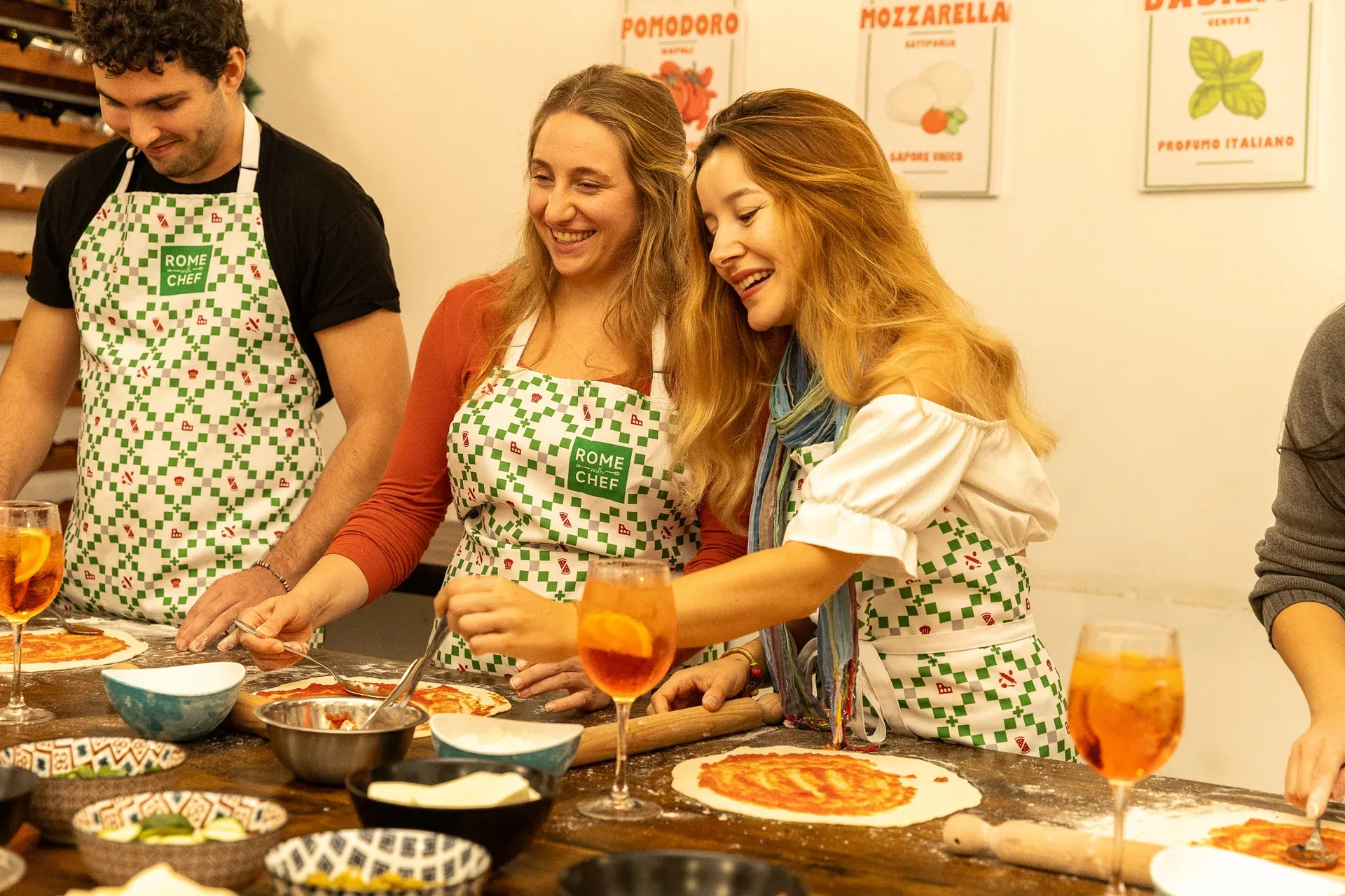
From December 1st until January 6th, our pizza class gets a merry makeover: mix your own seasonal spritz and indulge in a classic Italian Christmas dessert.
This isn’t your average elementary school pizza party; this is Rome, and we’re turning up the heat! Just ten minutes from the Colosseum, our high-energy cooking class is where pizzas fly and glasses are raised high.
In this dough-lightful evening experience, you’ll toss, top, and toast your way through a night of pizza-making, drink-sipping, and full-on Roman revelry. Ready to make your very own pizza? You’ll get a slice of pizza history from Rome and beyond, and a charismatic local chef will show you how to work the dough like a pro.
Roll, knead, and spread the dough before topping it off with everything your heart desires, except pineapple of course, we've got to stick to the rules. Then, as the dough rises, so does the mood because you'll get a crash course in Italian mixology. Sip on traditional Italian cocktails like Aperol and Hugo Spritz and socialise with your fellow chefs while your pizza bakes to Roman perfection.
Then, when everything is ready, it’s time to eat! You’ll dine like the Italians over a homemade pizza while continuing to sip on a Limoncello Spritz until your heart's content. You know the saying, when life gives you lemons, we turn it into a toast.
Whether you’re coming with friends, your amore, or are ready to make new pizza-loving pals, this isn’t just dinner, it’s a hands-on, wine-filled, flour-dusted party you’ll never forget.
So come hungry, bring your appetite for fun, and let’s raise a glass (and a pizza peel) to the tastiest night of your Roman holiday!
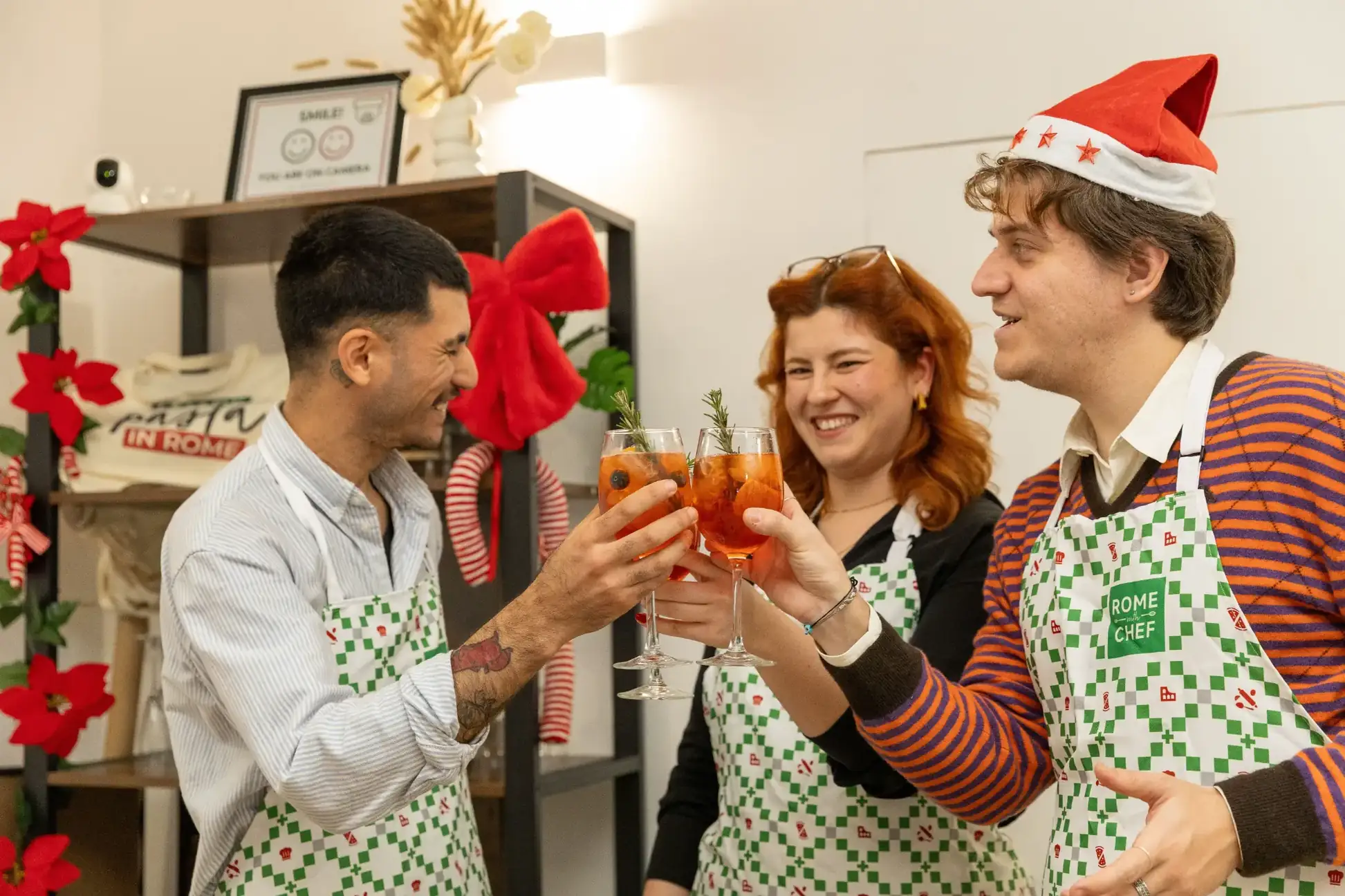
Twirl, sip, and soak up the seasonal cheer, because from December 1st to January 6th, we’re giving our usual class a holly-jolly glow-up. You’ll stir up a limited-edition cocktail packed with Yuletide spirit and finish with a classic Italian Christmas treat.
Did someone say Spritz? Discover the flavours of Rome on our Spritz and Spaghetti Class. Our centrally located kitchen is where you’ll learn everything you need to mix traditional Italian cocktails, and perfect the art of making fresh pasta. This is the only cooking class of its kind in Rome – a perfect blend of food, friends, and tipsy fun. So come join us and see what all the fuss is about!
Our team will welcome you and your small, intimate group with a mixology demo making Italy’s best-loved drink: Aperol Spritz. You’ll then get started on your hands-on pasta-making lesson led by a fun-loving, fluent professional chef before making a Hugo Spritz.
Your professional chef will guide you every step of the way – from kneading the dough to cutting the pasta. You’ll also be making a creamy carbonara sauce to coat your fresh pasta (vegetarians can try out another Roman classic of cacio e pepe). Travelling is all about meeting new people. At the end of this cooking class, you’ll dine on what you’ve made with a glass of Limoncello Spritz to wash it all down.
Book now and start making memories.
.webp)
Feed your curiosity as you please your palate on this indulgent Rome Food Tour! There's a reason our tour is multi-award-winning, and it's because we give you an all-access pass to savouring the Eternal City, stress-free. With everything pre-arranged, you’ll bypass the crowds as you taste your way through Rome; no queues, no guesswork—just authentic Roman cuisine. This fun (and filling) food tour gives you and a group of fellow foodies a taste of the city's culinary treasures, from local delicatessens and pizzerias to traditional trattorias and restaurants, you'll try all the authentic spots that the locals keep to themselves but your guide will reveal to you.
Our award-winning Rome food tour takes place in Trastevere, Rome's most traditional medieval neighbourhood. While the area is renowned for its buzzing nightlife and world-class cuisine, just like the rest of Rome, this neighbourhood also has its fair share of tourist traps. That's why we have teamed up with the places that keep to traditions and serve food for locals.
Because holidays are too short to eat badly, right?
This food tour in Rome will treat your tastebuds to at least 10 different tastings (vegetarian options available!) perfectly paired with a selection of local wines or non-alcoholic beverages for sober travellers. Try crispy Roman-style pizza by the slice, savoury supplì, and the best gelato in the city. Experience is more than just simply trying local cuisine, it's a glimpse inside the Roman kitchen—discovering the delicacies, the diet and the cultural dos and don’ts.
While you taste your way through the capital on this food tour; Rome will fully open up as you’ll also discover the process, meet the makers, and truly understand why Italian cuisine is considered the best in the world. So book your spot on our Rome Food Tour today and get ready for a true taste of the capital!
Please note: the places that we visit and the food that we try depend on the season.
Looking for a more intimate local experience with no strangers? We now offer an exclusive semi-private Rome food tour for groups of 6 or fewer.
This is a sustainable tour, meaning part of its profits go towards reforestation and other sustainable projects. We also ask all of our guests to bring a reusable water bottle to refill at one of the water fountains along our route to stay hydrated and help us reduce waste.
**Unfortunately, we can’t accommodate a gluten-free or vegan diet, but we hope to be able to in the future. While we can cater to vegetarians, we ask that you let us know about dietary requirements in advance so we can best suit your needs.**
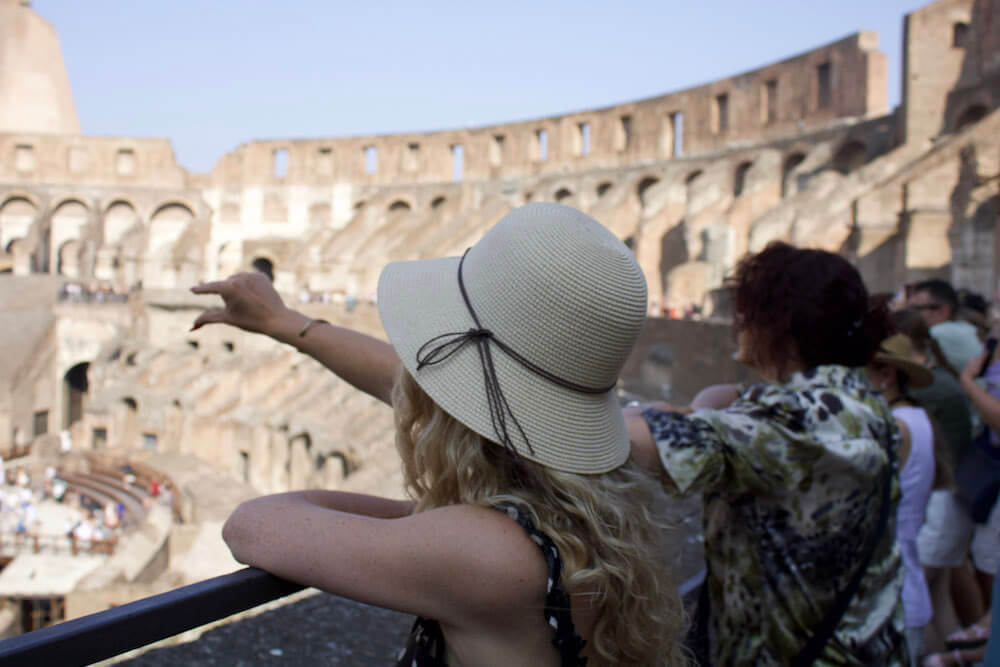
Explore ancient Rome's three must-see sites with an expert private tour guide! This Private Colosseum Tour with a guided visit of the Roman Forum and Palatine Hill is perfect if you're looking for a more personalised and immersive experience at a pace that suits you.
After meeting your private guide next to the 4th-century Arch of Constantine, and learning all about what Rome was like around the time the Colosseum was built, you’ll step straight inside the Colosseum, thanks to your timed entry tickets.
Your expert storyteller guide will bring the rich history of Rome’s iconic amphitheatre to life. They will reveal the story behind its construction and share the lives of those that fought and died there as you discover the gory norms of ancient entertainment, and geek out on the cult games and gladiatorial combat that thrilled the Colosseum's crowds.
Discover which animals the Romans caged beneath the Colosseum and how they transported them up onto the arena sands. Marvel at the architectural ingenuity of the Colosseum’s hypogeum (underground chamber) and retractable arena floor. And learn all about the social status of its spectators, divided according to class and gender.
After stepping outside the Colosseum, you'll walk along the ancient Via Sacra (Sacred Way), a route taken by triumphant generals celebrating their victories over Rome's enemies, and climb the Palatine Hill.
The Palatine is the most picturesque of Rome’s Seven Hills. It was the site on which Romulus founded the city in the 8th century BC. As Rome transformed from Republic to Empire, the Palatine Hill became the Beverley Hills of the ancient world. Your private guide will breathe life into the ruins of its luxury palaces and wow you with stories of the scandals and intrigues of Rome's imperial families.
Our final stop is the Roman Forum, the beating heart of ancient Rome. Venture through the commercial and cultural centre of the imperial capital and follow the footsteps of the emperors and legionaries alike. Your friendly expert guide will be at hand the whole time to answer all your questions to make sure you get the most out of your private Colosseum tour.
This pace of our Private Colosseum Tour is comfortable and leisurely, and we'll go at your pace. The tour lasts about 3 hours, giving you more than enough time to explore. Best of all, because you're in a private group you'll get dedicated attention from your private guide who will answer all your burning questions and give you personalised recommendations to make the most of your time in Rome.
If you want to upgrade your experience to gain access to the Colosseum's restricted areas, check out our Private Colosseum Arena Tour.
